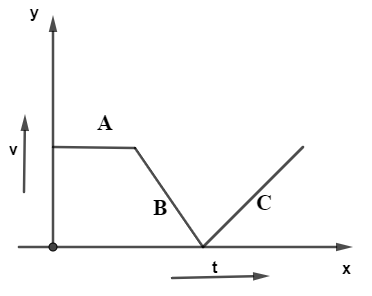
The velocity-time graph of a body is shown in the given figure. It implies that, over the section B the body experiences

(A) zero force
(B) force towards motion
(C) force opposing motion
(D) only force of gravity
Answer
218.4k+ views
Hint:In order to solve this question, we should know that in a velocity time graph, the slope of straight line gives us the acceleration, and force is directly proportional to the acceleration by newton’s second law so, using this concept we will understand the nature of force acting on the body during the section B as shown in the diagram.
Complete answer:
From Newton's second law we have, $F = ma$ where F denotes force, m is the mass of the body and ‘a’ is the acceleration of the body, so we see that force is directly related with the acceleration of the body. Now, from the given diagram we see that Y axis represents velocity v and X axis represent time t and during section B with increasing time velocity is decreasing or we can say that the slope which is $\dfrac{{dv}}{{dt}}$ will be negative and we know that the ratio of change of velocity with time or slope of velocity and time in v-t graph is acceleration, $a = \dfrac{{dv}}{{dt}}$ and as we know, velocity is decreasing with time so, slope which is acceleration a is negative.
Now, Negative acceleration implies that force acting on the body during section B is also negative as $F = ma$ so, a negative force implies that force is acting in a direction opposite to the direction of the motion of the body which means force is opposing the motion of the body.
So, During the section B from the given velocity-time graph diagram, force is opposing the motion of the body due to negative acceleration acting during that interval.
Hence, the correct option is Option (C).
Note:It should be noted while examining the velocity time graphs that in order to find nature if slope of path we need to check the change in velocity with increasing time and remember the basic formula of slope that slope is ratio of change in quantity represented at Y axis to the quantity represented at X axis.
Complete answer:
From Newton's second law we have, $F = ma$ where F denotes force, m is the mass of the body and ‘a’ is the acceleration of the body, so we see that force is directly related with the acceleration of the body. Now, from the given diagram we see that Y axis represents velocity v and X axis represent time t and during section B with increasing time velocity is decreasing or we can say that the slope which is $\dfrac{{dv}}{{dt}}$ will be negative and we know that the ratio of change of velocity with time or slope of velocity and time in v-t graph is acceleration, $a = \dfrac{{dv}}{{dt}}$ and as we know, velocity is decreasing with time so, slope which is acceleration a is negative.
Now, Negative acceleration implies that force acting on the body during section B is also negative as $F = ma$ so, a negative force implies that force is acting in a direction opposite to the direction of the motion of the body which means force is opposing the motion of the body.
So, During the section B from the given velocity-time graph diagram, force is opposing the motion of the body due to negative acceleration acting during that interval.
Hence, the correct option is Option (C).
Note:It should be noted while examining the velocity time graphs that in order to find nature if slope of path we need to check the change in velocity with increasing time and remember the basic formula of slope that slope is ratio of change in quantity represented at Y axis to the quantity represented at X axis.
Recently Updated Pages
Chemical Properties of Hydrogen - Important Concepts for JEE Exam Preparation

JEE General Topics in Chemistry Important Concepts and Tips

JEE Atomic Structure and Chemical Bonding important Concepts and Tips

JEE Amino Acids and Peptides Important Concepts and Tips for Exam Preparation

JEE Extractive Metallurgy Important Concepts and Tips for Exam Preparation

Algebra Made Easy: Step-by-Step Guide for Students

Trending doubts
JEE Main 2026: Application Form Open, Exam Dates, Syllabus, Eligibility & Question Papers

Derivation of Equation of Trajectory Explained for Students

Hybridisation in Chemistry – Concept, Types & Applications

Understanding the Angle of Deviation in a Prism

Understanding Collisions: Types and Examples for Students

Understanding Atomic Structure for Beginners

Other Pages
JEE Advanced Marks vs Ranks 2025: Understanding Category-wise Qualifying Marks and Previous Year Cut-offs

Units And Measurements Class 11 Physics Chapter 1 CBSE Notes - 2025-26

NCERT Solutions For Class 11 Physics Chapter 8 Mechanical Properties Of Solids

Motion in a Straight Line Class 11 Physics Chapter 2 CBSE Notes - 2025-26

NCERT Solutions for Class 11 Physics Chapter 7 Gravitation 2025-26

How to Convert a Galvanometer into an Ammeter or Voltmeter




